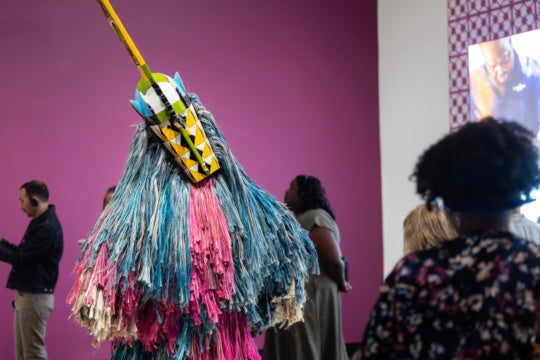
Tennessee artist John Douglas Powers, a 2016 Guggenheim Fellow, undertakes themes of myth and spirituality in his exhibition at the Knoxville Museum of Art. The works haunt the dimly lit gallery with cries that emanate from the creaky hinges of a kinetic sculpture. By constructing a mystical environment of its own, the exhibition draws on historical references to expose the origins of spiritual symbolism.
The source of the chorus of howls is Locus, a 22-foot-diameter motorized contraption that churns hundreds of finely crafted wood and metal parts. The movement causes tall, thin brass rods to sway back and forth as though they were reeds blowing in the wind. The material and form of the sculpture resembles a Leonardo da Vinci invention. The rhythmic movement of the rods is mesmerizing, but the mechanical groans disrupt that effect.
A looping video, Revenant, is projected on the wall behind Locus and reinforces the spectral impression of the exhibition. In it, clouds overlay two stone angel statues. The video is a mirrored image that generates clouds out of the centerline to pass through the shadowed figures. The stoic angels hover in their ominous heaven to the sound of lamenting. The imagery of Revenant combined with the sound of Locus evokes a baroque and spiritual aesthetic.

The third work, Omphalos, hides in plain sight compared to the other works. This sculpture is reminiscent of Brancusi’s Bird in Space in the way it commits itself to form. A base of white marble ascends into a surface covered in white feathers. It is hard not to reach out and touch the smooth and soft materials. In comparison to the other works, Omphalos feels sacred and pure. The work’s title is the Greek word for “navel” and references an ancient Greek artifact that symbolized the center of the world, such as the one at Delphi.
As a whole, the exhibition disposes of the conventions of spirituality or myth by breaking down the sum of an experience into its smaller parts. Both of the sculptures create an experience for the viewer using distinguishable earthly materials. The video combines symbolic imagery of sky and angels to make a celestial scene. By accentuating spirituality, the works question how it is that these symbols come to be supernatural. The Locus apparatus discloses the system of its operation, as if the machine itself could be a metaphor for ancient myth. The function of the sculpture does not lie in what the machine produces, but rather in the producing of the machine itself.
John Douglas Powers is an assistant professor of sculpture at the University of Tennessee in Knoxville. His work can be viewed at the Knoxville Museum of Art through August 7.
Kellie Bornhoft is an artist and writer living in Raleigh, North Carolina. She was a participant in Cycle 2 of BURNAWAY’s Art Writers Mentorship Program.




